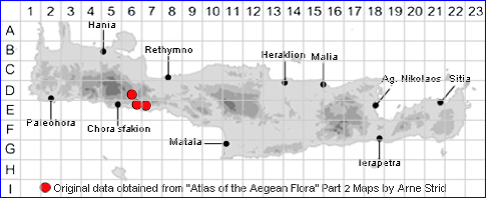
DIANTHUS JUNIPERINUS subsp. HELDREICHII
Common Names:- Wild carnation
Synonyms:- None
Meaning:- Dianthus (Gr) Zeus'-flower. a name used by the Greek philosopher
Theophrastus.
Juniperinus (L) Bluish-brown, juniper-like, (the colour of the berry).
Heldreichii (L) After Theodor Heinrich Hermann von Heldreich (1822-
1902). Director of the Athens Botanical Garden.
General description:- Small woody shrub.
Stems:-
1) Woody, branched, bearing herbaceous, flowering stems 6-10 cm, slender, 1- or
2-flowered.
Leaves:-
1) 0·5-2 cm, linear, abundant on non-flowering stems, 2 or 3 pairs on flowering
stems
Flowers:-
1) Inflorescence, with (1-)2-6 flowers not opening together.
2) Epicalyx-scales. 4-8, 1/3 - 1/2 as long as calyx, obcordate, with a subulate
apex.
3) Calyx, 10-13 x 2-3·5 mm, nearly cylindrical; teeth acute.
4) Petal-limb 5-6 mm wide, bright pink, with a few purple spots, shortly toothed
(dentate) or with rounded teeth (crenate).
Fruit:-
1) Capsule, splitting open to release the seeds (dehiscing) apically with 4 teeth;
carpophore often present.
2) Seeds, numerous, concave on 1 side.
Key features:-
1) Petals pinkish, at least above.
2) Epicalyx-scales obcordate, with subulate apex.
Habitat:- Calcareous rocks of the montane zone. 600-650 m.
Distribution:- Endemic west Crete. Rare.
Flowering time:- June-July
Photos by:- Fotis Samaritakis
Status:-
Conservation status (for threatened species): Vulnerable (V) according to IUCN
1997.
Protection status (for threatened species): Greek Presidential Decree 67/1981.
SPECIES DESCRIPTION
